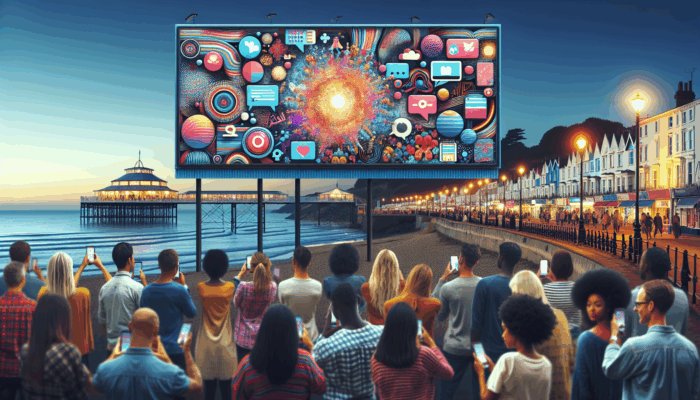Serving Content Amplification and surrounding areas for over 25 years.
Trusted by local business for reliable website design, SEO services and Digital Marketing in Somerset, Dorset, Devon, Wiltshire and Gloucestershire. 30 years of online marketing experience across the world.
Table of Contents
ToggleMaximising the Power of Social Media Amplification for Your Brand
What Exactly is Social Media Amplification?

Utilise Social Media for Content Amplification: Social media amplification is a strategic approach designed to significantly enhance the reach and visibility of your content across multiple social media platforms. This approach empowers content creators and brands to engage a much wider audience by inspiring users to share, like, and interact with their posts. The process transcends mere posting; it involves generating a ripple effect where a single share can snowball into multiple additional shares, potentially transforming a piece of content into a viral phenomenon. By harnessing the collective power of users, brands can dramatically increase their overall visibility and influence online.
To successfully amplify your content on social media, consider implementing these essential strategies:
- Create Engaging Content: Prioritise high-quality visuals and compelling narratives that truly resonate with your audience's interests and emotions.
- Encourage User Interaction: Stimulate engagement by prompting your followers to participate through questions, polls, or clear calls-to-action.
- Utilise Paid Promotions: Invest in targeted sponsored posts to effectively reach demographics that extend beyond your organic audience.
- Collaborate with Influencers: Partnering with influencers allows you to tap into their established audiences, significantly broadening your content's exposure.
- Leverage Trends: Incorporate trending topics and popular hashtags to boost your content's visibility and relevance.
- Cross-Promote Content: Share your content across multiple platforms to connect with various segments of your audience.
- Measure and Adapt: Use analytics tools to monitor your performance and refine your strategies based on what proves effective.
- Build a Community: Create a sense of belonging by consistently engaging with your audience, fostering loyalty and connection.
Implementing these strategies will not only enhance the visibility of your content but also deepen the connection with your audience, nurturing lasting relationships.
Listen With Me?
The Dynamics of Content Sharing on Social Media
Content sharing on social media represents a dynamic and interactive process where users share links, images, or videos on their profiles. This activity enables their followers to engage with the content, potentially leading to further shares and interactions. The true effectiveness of content sharing lies in its potential for virality; captivating content can swiftly spread across networks, reaching users well beyond the original audience. Understanding this mechanism is crucial for developing impactful social media strategies.
Successful content-sharing campaigns often utilise emotional storytelling, humour, or relatable experiences to capture attention. A prime example is the Ice Bucket Challenge campaign that raised awareness for ALS through user-generated content and social sharing, illustrating how a straightforward concept can engage millions globally. Similarly, Nike’s “Just Do It” campaign, which encourages personal stories of perseverance, has resulted in extensive sharing, enhancing brand loyalty and visibility. These cases demonstrate the immense potential of social media campaigns to spark conversations and foster connections among diverse audiences.
Furthermore, effective content sharing hinges on a keen understanding of your audience's preferences and behaviours. Content that resonates typically includes high-quality visuals, catchy headlines, and strong calls to action that motivate users to share the content. By analysing successful campaigns, brands can extract valuable insights to create similar impactful strategies that resonate across various demographics, ultimately amplifying their content reach.
Key Metrics to Evaluate Social Media Amplification Success
To accurately measure the success of social media amplification, brands must track specific metrics that provide insights into the effectiveness of their content strategies. Key metrics include reach, engagement rate, and share count. Reach indicates the number of unique users who have seen your content, while engagement rate reflects the level of interaction through likes, comments, and shares. The share count reveals how well your content resonates with users, showcasing its ability to be redistributed.
To effectively monitor these metrics, utilise social media analytics tools such as Google Analytics, Hootsuite, or Sprout Social. Begin by identifying your key performance indicators (KPIs) that align with your content objectives. For instance, if your goal is to boost brand awareness, focus on metrics that emphasise reach and shares. Conversely, if audience engagement is your priority, concentrate on interaction metrics.
Regularly reviewing these analytics will empower you to adjust your strategies based on performance data. For example, if a specific post type generates higher shares or engagement, consider replicating that style or topic in future content. Tracking these metrics not only informs your current strategies but also helps anticipate trends and adapt future campaigns for maximum impact.
Insights from Industry Experts on Effective Social Media Amplification

What Insights Do Experts Offer on Amplification Strategies?
Industry experts in digital marketing consistently emphasise the significance of leveraging social media as an essential tool for content amplification. They frequently emphasise the importance of creating shareable content, which often forms the foundation of successful amplification strategies. By crafting content that resonates emotionally with your audience, brands can significantly enhance their potential for engagement and sharing, ultimately leading to a broader reach and greater impact.
For instance, Gary Vaynerchuk, a prominent figure in social media marketing, frequently advocates for storytelling as a critical component of content creation. His insights suggest that brands should strive to understand their audience’s needs and craft narratives that address those needs directly. When content is thoughtfully constructed and relatable, it is far more likely to be shared. Similarly, Jay Baer, renowned for his digital marketing expertise, stresses the importance of creating useful and relevant content. His advocacy for utility-driven content implies that when users perceive content as valuable, they are more inclined to share it within their circles.
Integrating expert recommendations into your content strategies can dramatically enhance your amplification efforts. For example, focusing on creating infographics or concise, informative videos can cater to audiences' preferences for easily digestible content. Additionally, engaging with audiences through live sessions or Q&As can forge direct connections, encouraging users to share their experiences and insights within their networks.
Recommended Strategies from Leading Industry Professionals
Leading industry professionals advocate for a balanced approach that combines both organic and paid strategies for effective content amplification. Understanding audience behaviour is paramount; brands must tailor their content to resonate with their target demographics to achieve higher engagement levels and visibility.
To implement these strategies, consider the following actionable steps:
- Research Your Audience: Leverage tools such as surveys or analytics to identify interests, demographics, and preferences.
- Develop a Content Calendar: Plan your content to ensure a consistent flow of engaging posts that align with audience interests.
- Utilise Paid Promotions Smartly: Invest in targeted ads that reach specific audience segments based on their behaviours and interests.
- Experiment with Diverse Formats: Explore various content formats, such as videos, polls, or stories, to discover what resonates best with your audience.
- Engage Influencers: Identify and collaborate with influencers whose audiences align with your target market for broader reach and credibility.
- Monitor Industry Trends: Stay updated on relevant trends and adapt your content strategy accordingly to remain pertinent.
- Incorporate User Feedback: Regularly solicit and integrate user feedback to refine content and strategies, demonstrating that you value your audience's opinions.
By following these comprehensive steps, brands can develop a robust amplification strategy that resonates deeply with their audiences, driving engagement and visibility.
How Can Businesses Effectively Benefit from Expert Advice?

Businesses stand to gain immensely from adhering to expert advice on social media amplification. Experts provide invaluable insights into best practices, emerging trends, and effective techniques that can enhance content reach and engagement. By tapping into this expertise, brands can accelerate their learning curve, avoiding common pitfalls and mistakes.
One of the primary long-term benefits of embracing expert guidance is the potential for sustained brand growth. For instance, businesses that adopt content marketing principles, as advocated by leaders like Neil Patel, often experience increased traffic and engagement over time. Consistently applying expert-recommended strategies—such as producing high-quality, valuable content and leveraging data-driven insights—can lead to lasting customer loyalty and robust brand recognition.
Moreover, the social media landscape is ever-evolving. Experts are typically at the forefront of these changes, offering timely advice on how to adapt to new features or algorithm updates. This adaptability is crucial for maintaining relevance and effectiveness in content strategies. By integrating expert advice into their approaches, businesses can ensure that they are not only keeping pace with industry changes but also positioning themselves as thought leaders in their respective fields.
How Does Social Media Amplification Operate?
The Role of Algorithms in Social Media Amplification
Social media algorithms are central to the mechanics of content amplification. These algorithms dictate what content is displayed to users based on a variety of factors, including their interests, past interactions, and engagement patterns. Gaining a deeper understanding of how these algorithms function can significantly enhance the visibility of your content and increase engagement rates.
Each social media platform employs its unique algorithm that influences the reach of posts. For example, Facebook prioritises content that garners quick engagement, such as likes and comments, shortly after posting. In contrast, platforms like Instagram use a mix of engagement history and the timing of posts to determine visibility. Similarly, LinkedIn’s algorithm favours professional content and user engagement, which can influence how posts are shared within professional networks.
To optimise your content for improved visibility, brands should focus on crafting compelling headlines and visually appealing content that drives engagement. Additionally, encouraging timely interactions, such as comments or shares shortly after posting, can signal to algorithms that the content is valuable, thereby enhancing its reach. Understanding these nuances enables brands to tailor their strategies effectively and improve their overall amplification efforts.
User Engagement and Its Crucial Impact on Amplification
User engagement is a vital component in the amplification of content across social media platforms. Activities such as likes, comments, shares, and saves have a significant impact on the dissemination of content. High levels of engagement not only boost visibility through algorithmic favour but also foster community interaction and loyalty among followers.
Several key factors drive user engagement. Firstly, the emotional resonance of content plays a critical role; posts that evoke strong emotions—whether joy, sadness, or inspiration—tend to generate higher engagement rates. Secondly, the timing of posts can significantly impact engagement; sharing content when your audience is most active increases the likelihood of interaction. Lastly, consistency in posting helps maintain audience interest, encouraging ongoing engagement and fostering a deeper connection.
To enhance user engagement, brands can implement strategies such as incorporating interactive elements, like polls or questions, into their posts. Additionally, crafting storytelling content that invites audience participation can foster a sense of connection and encourage users to share their own experiences. By understanding and leveraging these engagement factors, brands can amplify their content more effectively and cultivate a loyal and engaged audience.
Timing and Frequency Strategies for Optimal Post Engagement
The timing and frequency of social media posts are critical for achieving effective amplification of content. Posting at optimal times can significantly enhance the reach of your content; research indicates that specific days and times yield higher engagement rates across various platforms.
To maximise the impact of your posts, consider these best practices for timing and frequency:
- Know Your Audience: Utilise analytics to determine when your audience is most active online, tailoring your posting schedule accordingly.
- Consistency is Key: Maintain a regular posting schedule to keep your audience engaged and anticipating your content.
- A/B Testing: Experiment with posting at different times and frequencies to identify what works best for your audience.
- Consider Time Zones: If your audience is global, schedule posts to effectively reach users across different time zones.
- Seasonal Trends: Align your posting schedule with seasonal trends or events that are relevant to your audience to maximise engagement.
- Utilise Scheduling Tools: Employ social media management tools to automate posting and ensure consistency in your schedule.
- Monitor Engagement Patterns: Regularly review analytics to adjust your timing strategy based on engagement data.
Implementing these practices can help brands optimise their content's reach and engagement, amplifying their overall social media presence and effectiveness.
The Impact of Paid Promotion on Amplification Success
Paid promotion plays a crucial role in amplifying content, enabling brands to target specific audiences more effectively. Through various advertising formats, businesses can significantly elevate their reach and engagement levels, resulting in greater visibility for their content.
Understanding the different ad formats available is crucial for maximising campaign effectiveness. For instance, Facebook offers a variety of ad options, including image ads, video ads, and carousel ads, each catering to diverse content types and audience preferences. Instagram excels with visually-driven ads, leveraging Stories and Reels to align with the platform’s emphasis on captivating visuals.
To leverage paid promotion effectively, brands should establish clear objectives for their campaigns. This might include increasing brand awareness, driving traffic to a website, or generating leads. Once objectives are defined, identifying the target audience becomes crucial; utilise the platform's targeting options to reach users based on demographics, interests, and behaviours.
Moreover, monitoring the performance of paid campaigns is vital. Analyse metrics such as click-through rates, engagement rates, and conversions to understand what resonates and refine future advertising efforts. By strategically employing paid promotion, brands can significantly amplify their content and enhance their overall marketing strategies.
The Essential Role of Influencers and Their Networks in Amplification
Influencers and social networks play a pivotal role in amplifying content, providing brands with a pathway to reach wider audiences while establishing credibility. Collaborating with influencers can significantly extend content reach, as these individuals often possess established trust and rapport with their followers, making their endorsements particularly powerful.
To effectively leverage influencer partnerships, brands should begin by identifying influencers whose values align with their own. This alignment ensures authenticity and resonates positively with their audience. Once suitable influencers are identified, brands can collaborate on content creation that highlights their products or messages in an organic and engaging way.
Influencer marketing can take various forms, ranging from sponsored posts to collaborative projects or events. These partnerships can enhance visibility and credibility, driving engagement through the influencer's network. Additionally, influencer collaborations can provide valuable insights into audience preferences, helping brands refine their content strategies and approaches.
Networking within social media platforms also plays a critical role in content amplification. Engaging with other brands, creators, and audiences through collaborations, co-hosted events, or cross-promotions can further extend reach. By cultivating a network of supportive relationships, brands can create a snowball effect that amplifies content, leading to sustained growth and engagement over time.
Advantages of Social Media for Content Amplification
Boosting Brand Visibility through Social Media Amplification
Utilising social media for content amplification can dramatically enhance brand visibility. When content is shared extensively across various platforms, it reaches a broader audience, significantly elevating brand recognition and enhancing overall visibility. This expanded reach is particularly advantageous in competitive markets, where distinguishing oneself is critical to achieving success.
Increased visibility yields numerous benefits for a business's marketing strategy. Firstly, it generates awareness among potential customers who might not have otherwise encountered the brand. As content circulates through social networks, users often discover and engage with the brand, ultimately leading to increased website traffic and potential conversions.
Moreover, consistent visibility helps build credibility and authority within the industry. When audiences repeatedly encounter a brand’s content, they begin to associate it with expertise and reliability. This perceived authority fosters customer loyalty, as individuals are more likely to engage with brands they trust and recognise. Therefore, enhanced brand visibility not only drives immediate engagement but also establishes a strong foundation for long-term brand success.
Fostering Enhanced Audience Engagement through Amplification
Social media platforms provide unparalleled opportunities for direct interaction with audiences, leading to higher engagement levels. Amplified content fosters community interaction, encouraging users to participate in discussions, share experiences, and form connections around the brand.
Through engaging content, brands can cultivate a sense of community among their audience. For instance, businesses that prompt discussions through open-ended questions or polls often experience increased engagement. This interaction not only strengthens relationships but also encourages users to share their insights and experiences with their networks, further amplifying reach.
Numerous successful engagement examples abound; brands like Starbucks effectively utilise social media to solicit feedback and input on new products, creating a participatory experience that resonates with customers. Similarly, Nike’s approach of utilising user-generated content encourages customers to showcase their unique stories, further linking the brand to personal narratives and building community.
Ultimately, enhanced audience engagement leads to stronger brand loyalty. When users feel valued and connected to a brand, they are more likely to become repeat customers and advocates. By fostering genuine engagement through social media amplification, brands can cultivate a loyal customer base that actively supports their products and services.
Cost-Effectiveness of Social Media Amplification
Social media amplification represents a cost-effective marketing strategy, enabling brands to reach wider audiences without the need for extensive advertising budgets. By leveraging existing platforms and user networks, businesses can maximise their marketing efforts efficiently and effectively.
One of the key cost-saving aspects of social media amplification is the organic reach that can be achieved through engaging content. High-quality, shareable content has the potential to go viral, reaching thousands or even millions of users at minimal or no cost. This organic engagement maximises return on investment, making social media a favourable alternative to traditional advertising methods.
Additionally, targeted paid promotions can provide cost-effective options for amplifying content. Social media platforms offer diverse budgeting options, allowing brands to set limits based on their marketing objectives. By carefully monitoring performance metrics, businesses can allocate resources effectively, ensuring that their marketing budget is spent wisely and efficiently.
Furthermore, social media amplification enables brands to cultivate organic relationships with their audiences, reducing the need for costly retention strategies. Engaged audiences are more likely to share content and refer others, creating a ripple effect that enhances visibility without additional expenditure. In summary, social media amplification not only maximises reach but also optimises marketing budgets effectively, making it a strategic choice for brands.
What Are the Best Practices for Effective Content Amplification?
Creating Highly Shareable Content
Creating inherently shareable content is essential for effective amplification. Shareable content often resonates with audiences on an emotional level, providing value or entertainment that encourages sharing. By comprehending the elements that make content shareable, brands can enhance their chances of widespread distribution and engagement.
Key characteristics of shareable content include:
- Emotional Appeal: Content that elicits strong emotions, whether joy, surprise, or sadness, is more likely to be shared widely.
- Relevance: Ensure that content aligns with audience interests and current trends to capture attention and engagement effectively.
- High-Quality Visuals: Compelling images or videos enhance the likelihood of shares, as visually appealing content tends to be more captivating.
- Informative Value: Providing valuable insights or useful information increases the chances of users sharing content to inform others.
- Call to Action: Encouraging users to share content through clear calls to action can significantly boost share rates.
- Originality: Unique or thought-provoking perspectives often motivate users to share as a means of expressing their individuality.
- Entertaining Content: Humorous or entertaining posts are highly shareable, often leading to viral engagement.
- Community Focus: Content that fosters a sense of belonging or community can motivate users to share within their networks, amplifying reach.
By incorporating these characteristics into your content creation process, brands can significantly enhance their chances of achieving substantial amplification through increased shares and engagement.
Effectively Leveraging Influencers for Amplification
Influencers play a crucial role in content amplification, offering businesses opportunities to expand their reach and credibility. Collaborating with influencers can introduce content to a wider audience, as their followers often trust their recommendations and insights.
To effectively identify and partner with the right influencers, brands should consider the following steps:
- Define Your Goals: Clearly outline what you wish to achieve through influencer partnerships, whether it’s enhancing brand awareness, driving engagement, or increasing sales.
- Research Potential Influencers: Identify influencers whose values and audience align with your brand. Tools like BuzzSumo or Upfluence can assist in this process.
- Evaluate Engagement Rates: Assess potential influencers based on their engagement rates rather than solely follower counts to ensure genuine interaction.
- Build Relationships: Engage with influencers by liking and commenting on their content, fostering rapport before proposing collaborations.
- Collaborate Creatively: Develop campaigns that allow influencers to showcase your brand authentically, whether through sponsored posts, giveaways, or co-created content.
- Track Performance: Monitor the effectiveness of influencer partnerships through metrics such as reach, engagement, and conversions to assess return on investment (ROI).
- Be Transparent: Ensure that promotions are clearly disclosed to maintain authenticity and trust with the influencer’s audience.
By applying these strategic steps, brands can maximise their influencer collaborations, enhancing content amplification while building lasting relationships with their chosen partners.
Utilising Hashtags and Trends for Enhanced Visibility
Hashtags and current trends are powerful tools for increasing the visibility of your content on social media. By strategically incorporating relevant hashtags and actively participating in trending topics, brands can significantly boost their amplification efforts.
To effectively use hashtags, consider these best practices:
- Research Trending Hashtags: Use tools like Hashtagify or Twitter Trends to identify hashtags currently gaining traction within your niche.
- Be Relevant: Ensure hashtags are directly related to your content to attract the right audience and enhance engagement.
- Mix Popular and Niche Hashtags: Combine widely used hashtags with more niche-specific ones to broaden reach while maintaining relevance.
- Limit Hashtags: While using multiple hashtags can increase visibility, overloading posts can reduce engagement. Aim for a balanced approach.
- Participate in Trends: Engage with trending topics or challenges to elevate brand visibility and connect with relevant audiences.
- Monitor Performance: Regularly assess which hashtags drive engagement and adapt your strategy accordingly for optimal impact.
- Create Branded Hashtags: Develop unique hashtags for campaigns to encourage user-generated content and foster community engagement.
By effectively leveraging hashtags and trends, brands can enhance the visibility of their content and foster greater engagement within their target audiences.
Optimising Content for Search Engines to Boost Amplification
Search engine optimisation (SEO) can significantly enhance content visibility and amplification. By implementing SEO best practices, brands can improve their chances of being discovered by users searching for relevant information online.
To optimise content for SEO, consider these strategies:
- Keyword Research: Identify relevant keywords that your audience is searching for and incorporate them strategically within your content.
- Use Meta Tags: Write compelling meta titles and descriptions, ensuring they include primary keywords to improve search engine rankings.
- Quality Backlinks: Foster relationships with reputable websites to earn backlinks, thereby enhancing your content's authority and visibility.
- Mobile Optimisation: Ensure that your content is accessible and user-friendly on mobile devices, as mobile optimisation is crucial for effective SEO.
- Engaging Visuals: Use high-quality images and videos while optimising them with alt text to improve searchability and engagement.
- Content Structure: Utilise headings, bullet points, and lists to improve readability and make it easier for search engines to index your content.
- Regular Updates: Update and refresh existing content to keep it relevant and improve its rankings over time.
By optimising content for search engines, brands can significantly enhance their visibility and amplify their reach, ensuring it resonates with a wider audience.
Engaging Actively with Your Audience to Foster Amplification
Engagement is key to amplifying content effectively. Proactively interacting with your audience fosters a sense of community and encourages users to share their experiences, thereby amplifying reach and visibility.
To increase audience engagement, consider these strategies:
- Respond to Comments: Engage with your audience by responding promptly to comments and messages, fostering a two-way dialogue.
- Encourage User-Generated Content: Motivate followers to share their experiences related to your brand, creating a sense of ownership and community.
- Host Interactive Sessions: Conduct live Q&As or webinars to invite direct interaction and foster deeper connections with your audience.
- Create Polls and Surveys: Use interactive content to solicit feedback and preferences, demonstrating that you value audience opinions.
- Share Behind-the-Scenes Content: Provide insights into your brand’s operations to create authenticity and build trust with followers.
- Run Contests or Giveaways: Encourage engagement by hosting contests that require users to interact with your content for entry.
- Utilise Stories: Leverage platform features like Instagram and Facebook Stories to share real-time updates and encourage engagement.
By implementing these engagement strategies, brands can cultivate a loyal community around their content, thereby significantly amplifying its reach and impact.
Research-Based Advantages of Using Social Media for Content Amplification
Studies Highlighting the Effectiveness of Amplification
Numerous studies have demonstrated the effectiveness of social media amplification in increasing content reach and engagement. These findings underscore the importance of utilising social media as a key component of modern marketing strategies.
Research indicates that content regularly shared on social media experiences significantly higher engagement rates compared to static content. An analysis of various social media campaigns revealed that brands leveraging amplification strategies saw a marked increase in organic traffic and lead generation. This data provides a compelling case for businesses to invest in and prioritise social media amplification as part of their marketing efforts.
Moreover, studies show that user-generated content yields higher engagement rates than traditional marketing methods. This highlights the effectiveness of creating a participatory environment where audiences feel empowered to share their experiences and stories. Brands that implement these strategies often observe substantial returns on investment through enhanced brand loyalty and a broader reach.
As brands continuously adapt their strategies based on research findings, they can optimise their content for maximum amplification. By employing data-driven insights, businesses can refine their marketing tactics and achieve more effective outcomes.
Data-Driven Insights into Audience Behaviour for Amplification
Data-driven insights into audience behaviour can profoundly inform content amplification strategies. Understanding how audiences interact with content enables brands to tailor their approaches for improved effectiveness and engagement.
To collect and analyse audience data, brands should leverage social media analytics tools to track engagement metrics, demographics, and user interactions. By examining this data, businesses can identify trends in audience preferences and behaviours, allowing them to create content that resonates more effectively.
For instance, identifying peak engagement times can guide posting schedules, ensuring that content reaches audiences when they are most active. Additionally, analysing which types of content receive the most engagement can inform future content creation efforts, allowing brands to focus on what works best for their target audiences.
Furthermore, audience feedback obtained through comments and surveys offers qualitative insights into preferences and expectations. By combining quantitative and qualitative data, brands can develop a comprehensive understanding of their audience, leading to more effective amplification strategies that drive engagement and visibility.
Ultimately, leveraging data-driven insights empowers brands to optimise their social media amplification efforts, ensuring that content resonates with audiences and drives meaningful engagement.
The Long-Term Impact of Social Media Amplification
The long-term impact of social media amplification can lead to sustained brand growth and increased customer loyalty. Research indicates that consistent amplification efforts yield significant benefits over time, establishing a lasting presence within the market.
Brands that invest in social media amplification often experience enhanced brand recognition and authority. As audiences become familiar with a brand through ongoing content engagement, they are more likely to choose that brand over its competitors. This familiarity breeds trust, a crucial element in encouraging long-term customer loyalty and advocacy.
Moreover, sustained amplification efforts contribute to the development of a growing community of followers who actively engage with the brand. This community can serve as brand advocates, sharing content within their networks and further amplifying the brand’s reach organically.
Numerous examples of businesses reaping long-term benefits from amplification exist. Companies like GoPro effectively utilise user-generated content to build a loyal following through consistent engagement and amplification strategies. As these practices become ingrained in a brand's marketing approach, the potential for sustained growth and customer loyalty only increases over time.
Case Studies Demonstrating Successful Content Amplification
Case studies provide concrete examples of how businesses have successfully utilised social media for content amplification, offering valuable insights into best practices and strategies. One notable example is Airbnb, which effectively leverages user-generated content to enhance its brand presence. By encouraging users to share their unique travel experiences, Airbnb amplifies its reach through authentic storytelling and community engagement.
Another successful case is Coca-Cola’s “Share a Coke” campaign, which personalised products by replacing the brand name with popular names, prompting consumers to share their experiences on social media. This campaign not only amplified brand visibility but also fostered a sense of connection among consumers, leading to increased engagement and sales.
These successful case studies highlight the critical factors that contribute to effective content amplification. Engagement with users, leveraging authentic stories, and creating shareable content are common themes that underscore successful strategies. By analysing these case studies, brands can derive actionable insights and replicate these effective practices to enhance their own content amplification efforts.
What Challenges Do Brands Face in Content Amplification?
Overcoming Algorithm Changes for Effective Amplification
Navigating the frequent changes in social media algorithms poses a significant challenge to content amplification. As platforms continually evolve their algorithms to enhance user experience, brands must adapt their strategies to maintain effectiveness and visibility.
One effective strategy for adapting to algorithm changes is to stay informed about updates through official platform announcements and industry news. By understanding how these changes impact content visibility, brands can adjust their approaches accordingly. For example, if a platform begins prioritising video content, brands may need to increase their focus on producing engaging video materials.
Additionally, diversifying content strategies can safeguard against algorithm fluctuations. Relying solely on one type of content can be risky; instead, brands should experiment with various formats—such as images, videos, stories, and live sessions—to determine what resonates best with their audience.
Regularly analysing performance metrics also plays a crucial role in adapting to algorithm changes. By tracking engagement and reach, brands can identify trends and make informed decisions about their content strategies. This proactive approach enables brands to stay relevant and maintain effective amplification efforts despite algorithmic shifts.
Effectively Managing Negative Feedback on Amplified Content
Managing negative feedback on amplified content is crucial for maintaining a strong brand reputation. Negative comments or criticism can significantly impact public perception, making it crucial for brands to handle such feedback effectively and professionally.
To navigate negative feedback, brands should adopt the following best practices:
- Respond Promptly: Address negative comments or concerns as soon as possible to demonstrate your commitment to customer satisfaction and openness.
- Stay Professional: Maintain a professional tone when responding, regardless of the nature of the feedback, to uphold brand integrity and credibility.
- Offer Solutions: Provide constructive solutions or alternatives to resolve complaints, showcasing your willingness to assist and improve.
- Encourage Private Discussions: If appropriate, invite users to discuss their concerns privately to prevent further negative exposure on public platforms.
- Monitor Brand Mentions: Utilise social media listening tools to track brand mentions, allowing for proactive responses to negative feedback.
- Learn from Feedback: View negative feedback as an opportunity for improvement, utilising it to refine your content and strategies moving forward.
By implementing these practices, brands can effectively manage negative feedback, enhance their reputations, and foster positive relationships with their audiences, thereby ensuring continued engagement and loyalty.
Ensuring High-Quality Content for Effective Amplification
Ensuring the quality of content is a significant challenge in amplification, as poor-quality content can hinder efforts and damage brand credibility. High-quality, engaging content is essential for successful amplification, making it imperative for brands to maintain high standards throughout their content production process.
To maintain content quality while amplifying, brands should adopt the following strategies:
- Develop a Comprehensive Content Strategy: Create a detailed content strategy that outlines objectives, audience personas, and content formats to ensure alignment and quality.
- Prioritise Quality Over Quantity: Focus on producing fewer, higher-quality content pieces rather than overwhelming audiences with low-quality outputs.
- Conduct Thorough Research: Ensure that all content is well-researched, accurate, and provides substantial value to the audience.
- Engage Skilled Creators: Collaborate with experienced writers, designers, and videographers to produce high-quality content that reflects your brand standards.
- Solicit Feedback: Encourage team members or trusted audience members to review content before publication, providing constructive insights for improvement.
- Update or Remove Outdated Content: Regularly review and refresh existing content to ensure it remains relevant, accurate, and engaging for your audience.
By prioritising content quality, brands can enhance their amplification efforts, ensuring that their content resonates positively with audiences and maintains credibility and trustworthiness in the market.
Proven Strategies for Effective Social Media Content Amplification
Proven Techniques to Amplify Your Content
Proven techniques for content amplification include leveraging user-generated content, running engaging social media contests, and employing strategic paid promotions. These techniques have been successful for numerous businesses, enabling them to effectively enhance their visibility and engagement.
User-generated content (UGC) serves as a powerful tool for amplification. By encouraging customers to share their experiences with your products, brands can tap into authentic storytelling that resonates deeply with potential customers. For example, campaigns that invite followers to share photos or testimonials can significantly enhance community engagement and amplify brand reach.
Social media contests represent another effective technique for amplification. By incentivising users to share content as part of a contest, brands can boost visibility and engagement levels. For instance, a photo contest that requires participants to tag friends or share posts can substantially increase reach and foster community interaction.
Paid promotions, when strategically employed, can further amplify content. Brands can target specific demographics based on interests and behaviours, ensuring that content reaches the most relevant audiences. This targeted approach can lead to higher engagement rates and conversions, reinforcing the overall effectiveness of amplification strategies.
These proven techniques provide brands with a roadmap to enhance their content amplification efforts, driving visibility and engagement while fostering authentic connections with their audiences.
Building a Strong Community Around Your Content
Building a community around content can significantly enhance amplification efforts. Engaged communities are more likely to share and interact with content, increasing its reach and impact. By fostering a sense of belonging, brands can create loyal advocates who champion their content within their networks.
To cultivate a community around your content, consider implementing the following actionable steps:
- Encourage Interaction: Prompt followers to share their thoughts, experiences, and ideas related to your content, inviting active participation and dialogue.
- Create a Dedicated Space: Establish a group or forum where followers can engage with one another and discuss topics related to your brand, enhancing community ties.
- Showcase User Contributions: Highlight user-generated content within your own channels, recognising and rewarding community participation to foster loyalty.
- Host Events or Webinars: Organise live sessions where followers can interact with your brand and each other, fostering connection and community engagement.
- Solicit Feedback: Regularly ask for input from your community regarding content and initiatives, ensuring they feel valued and heard.
- Be Consistent: Consistency in both content and engagement helps maintain the community’s interest and loyalty over time.
By implementing these strategies, brands can successfully build a strong community around their content, enhancing amplification efforts and fostering lasting relationships with their audiences.
Monitoring and Adapting Amplification Strategies
Monitoring the performance of amplification strategies and adapting them based on results is crucial for success. Continuous improvement can lead to better outcomes, allowing brands to optimise their efforts and enhance engagement levels.
To effectively monitor and adapt strategies, brands should establish key performance indicators (KPIs) that align with their amplification goals. These KPIs could include metrics such as engagement rates, share counts, and audience growth. Regularly reviewing these metrics helps identify areas of strength and opportunities for improvement.
Additionally, employing social media analytics tools allows brands to gain deeper insights into audience behaviour and content performance. By analysing which types of content resonate most, brands can refine their strategies to focus on high-performing formats and topics.
Furthermore, soliciting feedback from audiences can provide qualitative insights into their preferences and expectations. By combining quantitative data with qualitative feedback, brands can refine their strategies to better align with audience interests and enhance the effectiveness of their content.
Ultimately, a proactive approach to monitoring and adapting strategies empowers brands to stay ahead of trends and maximise the effectiveness of their amplification efforts.
Leveraging Influencer Partnerships for Amplification
Collaborating with influencers can significantly boost content reach and amplify brand visibility. To maximise the effectiveness of influencer partnerships, brands should adopt a strategic approach to their collaborations.
Begin by selecting influencers whose audiences align with your target market, ensuring authenticity and credibility in your partnerships. Conduct thorough research to evaluate potential partners, considering their engagement rates and the relevance of their content to your brand.
Once suitable influencers are identified, develop creative campaigns that allow them to showcase your brand authentically. This could involve sponsored posts, co-created content, or collaborative events that engage both audiences and create shared experiences.
Monitoring the performance of influencer partnerships is crucial. Track metrics such as engagement rates, conversions, and audience growth to assess the effectiveness of collaborations. This data-driven approach allows brands to refine their influencer strategies over time.
Ultimately, cultivating relationships with influencers fosters long-term partnerships that can significantly enhance brand visibility and credibility. By treating influencers as collaborators rather than mere promotional tools, brands can cultivate authentic connections that resonate with their audiences and effectively amplify their content.
Optimising Content for Each Social Media Platform
Each social media platform possesses unique features and audience behaviours, making it essential for brands to tailor content accordingly. Optimising content for different platforms can enhance engagement and amplification, ensuring that messages resonate with users effectively.
To optimise content effectively, consider the following tips:
- Understand Platform Characteristics: Research the specific features and audience behaviours of each platform to create content that aligns with user expectations and preferences.
- Utilise Visuals: Platforms like Instagram and Pinterest thrive on visuals, so prioritise high-quality images and videos that capture attention and engage users.
- Adjust Post Length: Tailor the length of your posts to fit the platform; shorter posts may work best for Twitter, while longer narratives are more suited for Facebook.
- Incorporate Platform-Specific Features: Utilise features such as Stories on Instagram or LinkedIn articles to engage users in unique and innovative ways.
- Utilise Hashtags Wisely: Research and apply platform-specific hashtags that enhance visibility while remaining relevant to the content.
- Engage with Platform Communities: Participate in conversations and groups unique to each platform to build connections and enhance reach.
- Consistency Across Platforms: While optimising content, maintain a consistent brand voice and message across all platforms for recognisability and trust.
By following these optimisation tips, brands can tailor their content to suit each platform's unique characteristics, enhancing engagement and amplifying their overall reach successfully.
Frequently Asked Questions
What is social media amplification?
Social media amplification refers to the process of increasing the reach and visibility of content by sharing, liking, and engaging with it on social media platforms, thereby expanding its audience and impact.
How can I measure the success of my amplification efforts?
You can measure success by tracking key metrics such as reach, engagement rate, and share count using social media analytics tools to assess the effectiveness of your strategies.
What types of content are most likely to be shared?
The most shareable content typically includes emotional narratives, high-quality visuals, informative articles, and entertaining posts that resonate deeply with the audience's interests and experiences.
How frequently should I post content on social media?
The optimal frequency of posting depends on your audience and platform; however, consistency remains key. Experiment to identify the best posting schedules that yield the most engagement for your content.
What role do influencers play in content amplification?
Influencers can significantly extend your content's reach by sharing it with their established audiences, lending credibility and authenticity to your brand while fostering engagement.
How can I encourage user engagement on my posts?
Encourage engagement by responding to comments, asking questions, hosting polls, and sharing user-generated content to foster a sense of community interaction and connection.
What are the benefits of using paid promotions for amplification?
Paid promotions enable targeted outreach to specific demographics, significantly increasing visibility and engagement rates for your content while enhancing overall marketing effectiveness.
How do I adapt to algorithm changes on social media?
Stay informed about algorithm updates, diversify your content strategies, and regularly analyse performance metrics to adjust your approaches as needed for optimal effectiveness.
What are effective strategies for managing negative feedback?
Respond promptly with professionalism, offer constructive solutions, and invite private discussions to resolve issues while maintaining a positive brand reputation and relationship with your audience.
How can I ensure the quality of my amplified content?
Maintain content quality by developing a robust strategy, prioritising high-quality production, and regularly reviewing existing content to ensure relevance and accuracy.

















